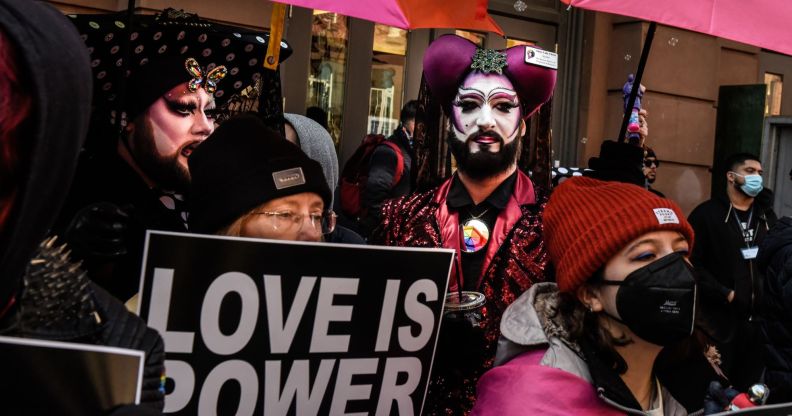Drag Story Hour director: Republicans want to legislate LGBTQ+ people out of existence

Drag Story Hour executive director Jonathan Hamilt says the group’s events have faced violent threats, performers being doxxed and immense hate as a result of anti-LGBTQ+ sentiment in the US. (Getty)
Drag bans are just the start of an attempt to “eradicate” the LGBTQ+ community, says the executive director of Drag Story Hour.
Drag Story Hour has been holding events across the US since 2015, with drag performers reading stories to children, creating affirming and inclusive spaces where kids can be their authentic selves.
These events have always been the target of protests – but in recent years, demonstrations have turned from peaceful to violent, and are now routinely attended by far-right and neo-Nazis groups including the Proud Boys.
More than 140 drag events were attacked or threatened with violence last year, according to GLAAD.
Drag Story Hour executive director, Jonathan Hamilt, tells PinkNews that protests started becoming unsafe after the Trump presidency and 6 January Capitol riots.
“There’s a big difference in exercising your freedom of speech with peaceful protests across the street versus what we’ve been seeing since January 6th,” he says.
He listed hate groups targeting the programme, instilling violence and fear with homophobic and transphobic rhetoric, and people showing up with guns, as just part of the problem.
Storytellers are also being doxxed or getting hate mail, Hamilt added.
As well as protests and abuse, drag queens are being targeted by Republican legislators across the country. Tennessee governor Bill Lee signed the first-in-the-nation ban on drag performances in public spaces and in front of minors into law on 2 March. Other states are pursuing similar legislation.
Hamilt says it’s a “tale as old as time” – conservatives targeting a marginalised group instead of enacting policies that will work on “all the things that the country so desperately needs to fix”.
“They’re trying to target a marginalised group which they think is weak, and use drag as scapegoats for this moral panic, to start chipping away at LGBT, queer and trans rights,” he explains.
“You start with art and culture and start chipping away. Then, before you know it, we’re completely eradicated and legislated out of existence.”

As well as hostility from politicians and far-right groups, drag performers are also being targeted by the right-wing press.
A Media Matters report found that anti-drag reports by right-wing media organisations – including Fox News and The Daily Wire – increased in the weeks before an individual firebombed a doughnut shop in Tulsa, Oklahoma, that hosted a drag event.
Hamilt believes conservatives wouldn’t have an issue with drag if the art form didn’t have its roots in the LGBTQ+ community.
“If it was pantomime, miming, Disney princesses or something else, no one would care,” he says. “But the fact that queer people are using this art form, that’s where they have an issue with it.
“And you know, straight people have their own drag queens – they’re called politicians. We all do drag.”
The LGBTQ+ community and its allies are fighting back – they’ve held up rainbow-coloured umbrellas to protect attendees at events, shouted their support for the LGBTQ+ community and played joyful music to drown out the hate.

Hamilt believes this the sparks of resistance won’t ever be extinguished.
“The revolution will not be televised, it’s not going to be on Facebook, Zoom, Instagram or TikTok,” he says. “I recently travelled to the San Francisco chapter. We did a Story Hour in Texas.
“Meeting with people and being in the community in-person and doing our programme is the therapy. It is the protest.”
How did this story make you feel?

